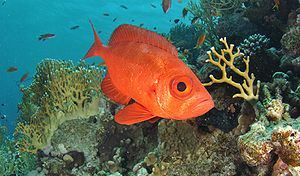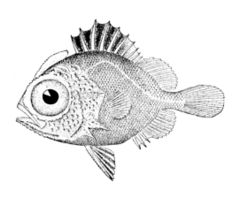
Priacanthidae
Encyclopedia
Priacanthidae is a family of fish
, common name
bigeye, comprising 18 species of marine fishes. "Catalufa
" is an alternate common name for some members of the priacanthidae family. The etymology
of the scientific name ("prioo-", to bite + "akantha", thorn) refers to the family's very rough, spined scales. The common name of "bigeye" refers to the member species' unusually large eye
s, suited to their carnivorous
and nocturnal lifestyles. Priacanthidae are most typically colored bright red, but other coloration patterns do exist for some species. Most species reach a maximum total length of about 30 centimeters (12 inches), although in a few species lengths of over 50 centimeters (20 inches) are known.
_.jpg) Members of this family are native to the tropical and subtropical regions of the Atlantic
Members of this family are native to the tropical and subtropical regions of the Atlantic
, Indian
, and Pacific Ocean
s, where they tend to live near rock outcroppings or reef
s, although a few are known to inhabit open waters. Some species are fished as a food fish.
 The earliest identified Priacanthidae fossil
The earliest identified Priacanthidae fossil
s date to the middle Eocene
epoch of the lower Tertiary
period, or roughly 40 to 50 million years ago.
 There are 18 species in 4 genera:
There are 18 species in 4 genera:
Fish
Fish are a paraphyletic group of organisms that consist of all gill-bearing aquatic vertebrate animals that lack limbs with digits. Included in this definition are the living hagfish, lampreys, and cartilaginous and bony fish, as well as various extinct related groups...
, common name
Common name
A common name of a taxon or organism is a name in general use within a community; it is often contrasted with the scientific name for the same organism...
bigeye, comprising 18 species of marine fishes. "Catalufa
Catalufa
Catalufa is the common name for three species of fish belonging to the Priacanthidae family:*Heteropriacanthus cruentatus*Priacanthus arenatus*Pristigenys serrula - the popeye catalufa...
" is an alternate common name for some members of the priacanthidae family. The etymology
Etymology
Etymology is the study of the history of words, their origins, and how their form and meaning have changed over time.For languages with a long written history, etymologists make use of texts in these languages and texts about the languages to gather knowledge about how words were used during...
of the scientific name ("prioo-", to bite + "akantha", thorn) refers to the family's very rough, spined scales. The common name of "bigeye" refers to the member species' unusually large eye
Eye
Eyes are organs that detect light and convert it into electro-chemical impulses in neurons. The simplest photoreceptors in conscious vision connect light to movement...
s, suited to their carnivorous
Carnivore
A carnivore meaning 'meat eater' is an organism that derives its energy and nutrient requirements from a diet consisting mainly or exclusively of animal tissue, whether through predation or scavenging...
and nocturnal lifestyles. Priacanthidae are most typically colored bright red, but other coloration patterns do exist for some species. Most species reach a maximum total length of about 30 centimeters (12 inches), although in a few species lengths of over 50 centimeters (20 inches) are known.
_.jpg)
Atlantic Ocean
The Atlantic Ocean is the second-largest of the world's oceanic divisions. With a total area of about , it covers approximately 20% of the Earth's surface and about 26% of its water surface area...
, Indian
Indian Ocean
The Indian Ocean is the third largest of the world's oceanic divisions, covering approximately 20% of the water on the Earth's surface. It is bounded on the north by the Indian Subcontinent and Arabian Peninsula ; on the west by eastern Africa; on the east by Indochina, the Sunda Islands, and...
, and Pacific Ocean
Pacific Ocean
The Pacific Ocean is the largest of the Earth's oceanic divisions. It extends from the Arctic in the north to the Southern Ocean in the south, bounded by Asia and Australia in the west, and the Americas in the east.At 165.2 million square kilometres in area, this largest division of the World...
s, where they tend to live near rock outcroppings or reef
Reef
In nautical terminology, a reef is a rock, sandbar, or other feature lying beneath the surface of the water ....
s, although a few are known to inhabit open waters. Some species are fished as a food fish.

Fossil
Fossils are the preserved remains or traces of animals , plants, and other organisms from the remote past...
s date to the middle Eocene
Eocene
The Eocene Epoch, lasting from about 56 to 34 million years ago , is a major division of the geologic timescale and the second epoch of the Paleogene Period in the Cenozoic Era. The Eocene spans the time from the end of the Palaeocene Epoch to the beginning of the Oligocene Epoch. The start of the...
epoch of the lower Tertiary
Tertiary
The Tertiary is a deprecated term for a geologic period 65 million to 2.6 million years ago. The Tertiary covered the time span between the superseded Secondary period and the Quaternary...
period, or roughly 40 to 50 million years ago.
Species

- Genus Cookeolus
- Longfinned bullseye, Cookeolus japonicus (CuvierGeorges CuvierGeorges Chrétien Léopold Dagobert Cuvier or Jean Léopold Nicolas Frédéric Cuvier , known as Georges Cuvier, was a French naturalist and zoologist...
, 1829).
- Longfinned bullseye, Cookeolus japonicus (Cuvier
- Genus Heteropriacanthus
- Glasseye, Heteropriacanthus cruentatusHeteropriacanthus cruentatusHeteropriacanthus cruentatus is a fish from the around the globe, in tropical seas. It occasionally makes its way into the aquarium trade. It grows to a size of 50.7 cm in length....
(Lacépède, 1801).
- Glasseye, Heteropriacanthus cruentatus
- Genus Priacanthus
- Alalaua, Priacanthus alalaua Jordan & Evermann, 1903.
- Atlantic bigeye, Priacanthus arenatus CuvierGeorges CuvierGeorges Chrétien Léopold Dagobert Cuvier or Jean Léopold Nicolas Frédéric Cuvier , known as Georges Cuvier, was a French naturalist and zoologist...
, 1829. - Paeony bulleye, Priacanthus blochii BleekerPieter BleekerPieter Bleeker was a Dutch medical doctor and ichthyologist, famous for his work on the fishes of East Asia – Atlas Ichthyologique des Orientales Neerlandaises – which was published 1862–1877....
, 1853. - Priacanthus fitchi Starnes, 1988.
- Moontail bullseye, Priacanthus hamrur ForsskålPeter ForsskålPeter Forsskål, sometimes spelled Pehr Forsskål, Peter Forskaol, Petrus Forskål or Pehr Forsskåhl, was a Swedish explorer, orientalist, naturalist and an apostle of Carl Linnaeus.-Early life:...
, 1775. - Red bigeye, Priacanthus macracanthus CuvierGeorges CuvierGeorges Chrétien Léopold Dagobert Cuvier or Jean Léopold Nicolas Frédéric Cuvier , known as Georges Cuvier, was a French naturalist and zoologist...
, 1829. - Hawaiian bigeye, Priacanthus meekiPriacanthus meekiPriacanthus meeki is a red fish found in Hawaiian and Midway Islands. It occasionally makes its way into the aquarium trade. It grows to a size of 33 cm in length. Common names are Hawaiian bigeye in English and āweoweo in the Hawaiian language...
Jenkins, 1903. - Priacanthus nasca Starnes, 1988.
- Elongate bulleye, Priacanthus prolixus Starnes, 1988.
- Arrow bulleye, Priacanthus sagittarius Starnes, 1988.
- Purple-spotted bigeye, Priacanthus tayenus RichardsonJohn Richardson (naturalist)Sir John Richardson was a Scottish naval surgeon, naturalist and arctic explorer.Richardson was born at Dumfries. He studied medicine at Edinburgh University, and became a surgeon in the navy in 1807. He traveled with John Franklin in search of the Northwest Passage on the Coppermine Expedition of...
, 1846. - Priacanthus zaiserae Starnes & Moyer, 1988.
- Genus Pristigenys
- Short bigeye, Pristigenys alta (Gill, 1862).
- Pristigenys meyeri (Günther, 1872).
- Japanese bigeye, Pristigenys niphonia (CuvierGeorges CuvierGeorges Chrétien Léopold Dagobert Cuvier or Jean Léopold Nicolas Frédéric Cuvier , known as Georges Cuvier, was a French naturalist and zoologist...
, 1829). - Popeye catalufa, Pristigenys serrulaPristigenys serrulaPopeye catalufa is a fish from the Eastern Pacific. It occasionally makes its way into the aquarium trade. It grows to a size of 34cm in length....
(Gilbert, 1891).

